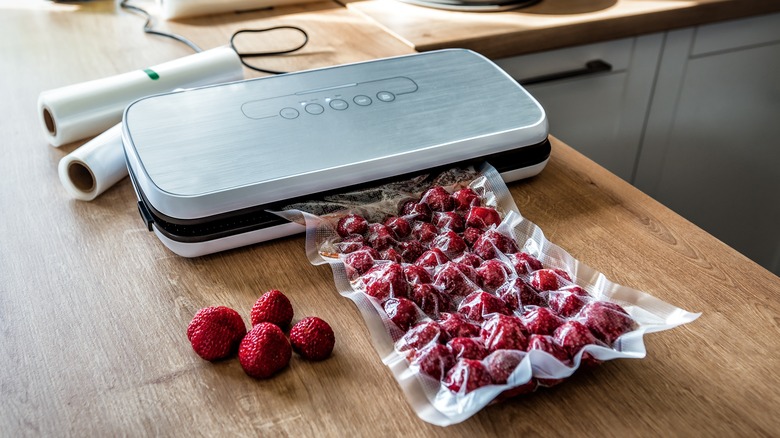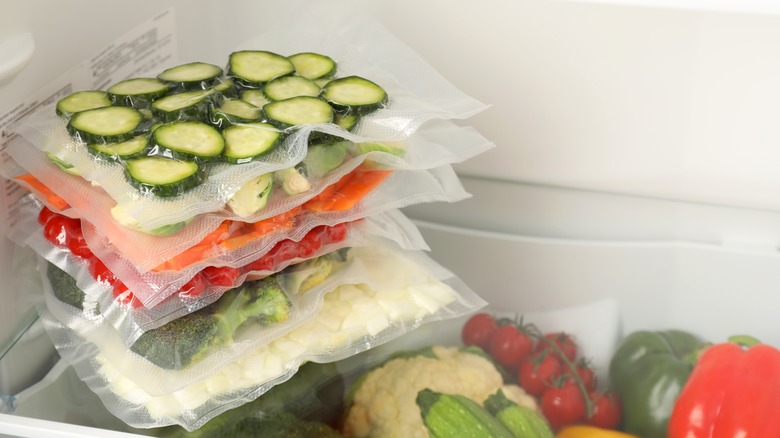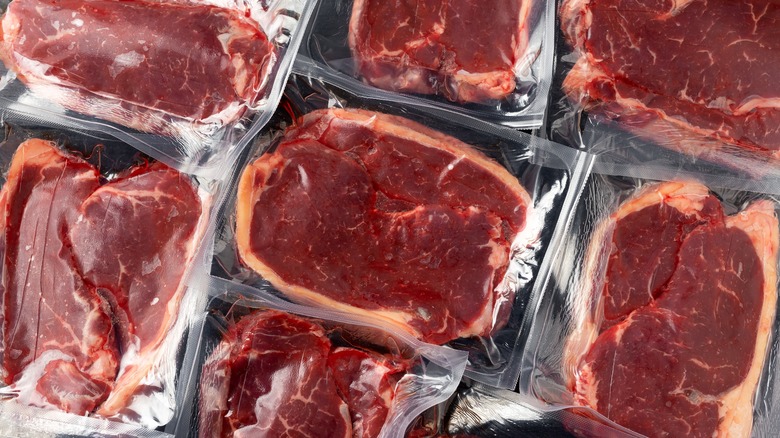The Game-Changing Gadget For Home Chefs With A Ton Of Leftovers
With large batches of food comes large batches of leftovers. And while you may be used to storing them in plastic containers or bags, there's a gadget that can extend the life of your meat, cheese, vegetables, and bread even further. We're talking about the vacuum sealer, a staple in every commercial kitchen that's now readily available for the home chef.
The vacuum sealer serves one purpose — removing air from storage bags and firmly sealing them shut in just a few seconds. This simple process reduces oxygen and preserves the food within by limiting exposure. This significantly reduces most bacterial growth, dramatically extending the lifespan of your leftovers. When properly vacuum-sealed, meat that would last six months in the freezer can be stored for up to two years.
This tool expertly reduces freezer burn, a pesky problem that occurs when a food's surface is exposed to cold, dry air. And in addition to longer storage times, vacuum-sealed leftovers can preserve the color, texture, and flavor of your culinary creations, turning groans of "leftovers again?" into cheers of "leftovers again!"
Vacuum sealers can get expensive, with commercial models costing thousands. But the budget-conscious chef can choose from a variety of models, ranging from efficiency units under $100 to pricier options that can handle anything from component cooking meal prep to salvaging large batches of surplus food.
Tips for maximizing your vacuum sealer's potential
Consider using your vacuum sealer to marinate your food. While it's a good idea to use a gallon bag for a safe raw chicken marinade, the perfectly pressurized environment of a vacuum-sealed bag will press flavors into your protein or produce more evenly. These packs stack efficiently, so you can marinate a week's worth of dinners without compromising valuable refrigerator real estate or risking any spills.
Need to store your garden's bounty? The vacuum sealer can extend the life of your vegetables beyond the summer season; simply blanch them in water for one to five minutes. While you should avoid blanching onions, garlic, or mushrooms, this method works for most produce and adds an eight to 12-month shelf-life when properly stored in a freezer. Jams and sauces that you'd normally store in a mason jar can also benefit from vacuum sealing, making these preserves easier to store and stack in the fridge and freezer.
And if you have a sous vide circulator, there's even more reason to own a vacuum sealer. From cooking bacon sous-vide-style to tenderizing a tough cut of meat, the sous-vide method makes slow cooking easy by heating vacuum-sealed meals in a temperature-controlled water bath. Because vacuum sealers use heat to melt and completely seal the bag after removing all the air, there's virtually no chance that water will work its way into your food while cooking.
Vacuum sealing best practices for food saftey
Keep in mind that vacuum-sealing perishable food doesn't make it shelf-stable. To maintain safety, leftovers need to go in the fridge within two hours of sitting at room temperature. When storing sauces, broths, or soups, freeze them in an open bag beforehand. Once the contents are semi to fully frozen, you can extract the air and seal the bag at the last second. Not only does freezing make it easier to vacuum-seal wet foods, but it can potentially kill off bacteria and preserve your food's nutrients and texture.
Raw onions, fresh garlic, and fresh mushrooms are also a no-no for vacuum sealing, as they contain botulinum. This potentially dangerous anaerobic (oxygen-free) bacterium thrives in a vacuumed environment. Fish is also susceptible to anaerobic toxins like botulinum, particularly when thawed in a sealed bag. This meal prep mistake could cause food poisoning, so vacuum-sealed frozen fish needs to be removed from the plastic before it can safely defrost in the fridge.
It's also important to label your bags, so you remember how long they've been sitting in the fridge or freezer. Write down the contents and the date, and stack each bag chronologically, with older food toward the front and newer leftovers set further back. With a well-organized rotation system, you can reduce spoilage and save money without reducing the quality of your culinary creations.



